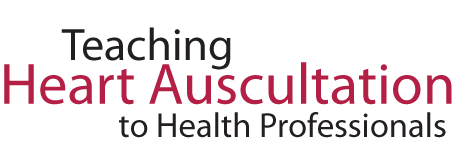CHAPTER 10
Recommended Curricula for Teaching Heart Sounds Auscultation
John P. Finley MD CM
Dalhousie University
Halifax, Nova Scotia
Michael J. Barrett MD
Temple University School of Medicine
Philadelphia, Pennsylvania
Andrew S. Mackie MD SM
University of Alberta
Edmonton, Alberta
At the time of writing, undergraduate medical education curricula are undergoing rapid and significant changes in both format and content. The new curricula typically feature distance learning, simulation and integration of clinical and basic science learning. Skills teaching in some curricula is being revised, and may utilize video presentation and simulation but unfortunately may lack patient contact or personal interaction with a teacher. Newer concepts of teaching auscultation may or may not be informing the revised curricula.
With this evolving background there is no auscultation curriculum which fits all medical education programs. The best teaching and learning program for a particular institution will take advantage of the strengths of the resources available, especially the teaching staff. As noted in the chapters by Drs Mackie and Finley, much of auscultation teaching and assessment is not evidence- based and there is much scope for research in this context.
Nonetheless there are effective teaching principles outlined in this book which should be the foundation of any auscultation teaching curriculum. We offer below a template for curricula for physicians and nurses. The actual timing of the teaching will depend on the institution; we assume a 4 year program of medical education with clerkship in years 3 and 4. The important elements are the sequence of teaching sessions, opportunity for small group teaching with a mentor, self- learning, much repetition, obligatory assessment using a mastery model with a minimum passing score, online recordings and materials, and reinforcement several times in subsequent years after the principal teaching segment. In addition to this outline it is assumed there will be some auscultation experience in small group bedside teaching and clinical rotations.
Undergraduate Medical Education
Year 1 – introduction to physiology of heart sounds, large group listening for illustration. Online access to normal heart sounds.
Year 2 – small/medium group teaching and listening
- self directed learning for minimum of 500 repetitions of heart sounds and murmurs using online/ downloaded recordings. Emphasis on normal vs abnormal, and only common abnormalities.
- obligatory assessment, possibly online, requiring mastery to a minimum score
- reinforcement/review session, possibly online, once in Year 2
Years 3-4 – at least 2 reinforcement/review sessions
- OSCE assessment should be considered for Pediatrics and Internal medicine rotations
Postgraduate Medical Education
Emphasis on heart auscultation will depend on specialty. Family medicine, Internal medicine and Pediatrics should have an obligatory curriculum. Pediatric cardiology and adult cardiology would have an advanced level curriculum. Online resources will be essential. Specific objectives and teaching sessions will be important, and assessment will be the key to successful learning.
Continuing Medical Education
Credit should be available for auscultation learning programs which could be online, at conferences and through refresher courses. These should be available in several levels of difficulty, appropriate to the type of practice of the individual practitioner.
Nursing and Other Health Professions
Because of the wide scope of practice, for nursing, paramedical personnel and other health professions, recommendation of specific curricula is not feasible. However, it is likely that insufficient emphasis is placed on heart auscultation in many training courses. Recognition of normal vs abnormal should be the most important objective of any program. Recordings, online or downloaded, should be available containing uncomplicated examples with provision for much repetition and later assessment of skill. Learning with a mentor remains a highly valuable experience.


